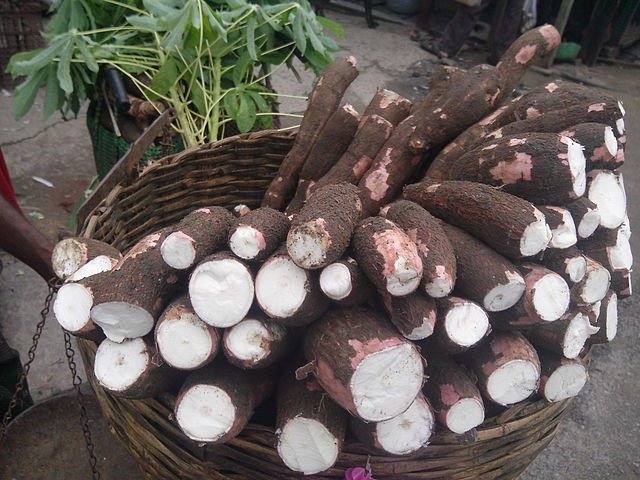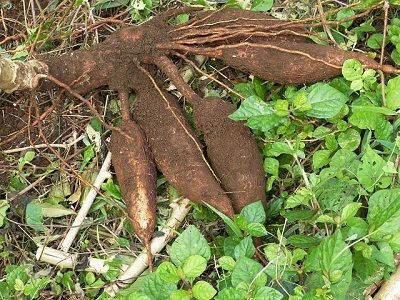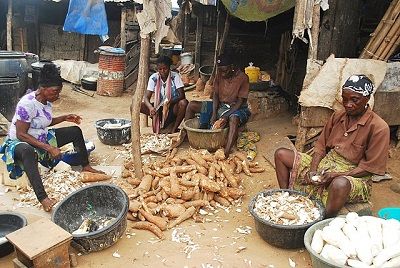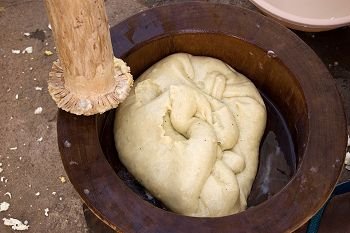Little saviour in the tropics: Cassava

When the Portuguese came to Nigeria, they brought several things with them. They brought the Christian faith, guns, mirrors, fabrics, a received language and more. In their cargo holds, they had something that Nigerians did not know the value of then but is now so integrated into the life of Nigerians, that there is no home in Nigeria that you will go to where it is not found. I am talking about cassava.Yes, cassava is not indigenous to Nigeria. It was brought by visitors from across the seas and it has stayed on to become one of the most consumed food staples in the country.
Cassava is botanically/scientifically known as Manihot esculenta Crantz. Even though it was first known as Manihot utilissima Pohl, the plant’s species name was changed from utilissima to esculenta and the authorship also changed from Crantz to Pohl respectively. The plant is indigenous to the countries of the American continent. It was already being consumed by the indigenous peoples of that continent before the Portuguese arrived there and discovered its uses and benefits, then carried it along with them on their voyages of reconnecting and trading with continents long forgotten in the midst of time. Explorers like Pierre Martyr in 1494 and Dr Livingstone in 1854 commented on the presence and use of the cassava plant in Brazil and Angola respectively.
The plant found its way to the Orient around year 1850 where it flourished until rubber (Hevea braziliensis) took over as the cash crop of choice. It is presently grown in most of the countries in the tropics and competes favourably with sweet potato as a source of starch.
Nigeria is presently one of the largest producers and consumer of the cassava plant and its products. The plant is mainly grown as a source of food but it is also used in industrial products. Cassava plant is mostly grown in the Southern part of the country, areas where the Portuguese first landed their ships upon their visit to Nigeria. Places in Delta, Edo and Ogun States are known for the quality of their cassava products. Variety of products from this plant are also exported to other parts of the country as well as neighbouring countries.
The most important part of cassava is the modified root which is known as underground tuber, although the stem and leaves are utilized in several other uses. Propagation involves stem cutting of about one feet in length and . A matured stem of the plant is cut planted in the ground, most times on heaps or ridges. The planted stem gradually grows roots that anchor it to the soil and young leaves that seek the sun for food through the process of photosynthesis.
Its roots are where the food is stored in form of tubers and during harvest, the stem is uprooted and the tuber cut away from the stem. The stem of a harvested cassava can be replanted to grown fresh tubers. Local breeds of cassava grow within two to three weeks of planting and mature for harvest within one and a half to two year’s period. Continous research, however, has led to the availability of improved hybrids which grow and mature within six months to a year. Thanks to research institutes like International Institutes for Tropical Agriculture (IITA).
Like most plants in the tropics, diseases and pests are never far away. The plant has intrinsic resistance to a lot of local pests and diseases. Consequently, it is quite a sturdy crop but may still be attacked by pathogenic diseases such as mosaic, a viral disease that attack leaves, stems and branches; bacterial pathogens such as Phytomonas manihotis and a host of others which attack roots as well as stems and leaves. Insects like beetles, locusts and aphids serve as pests and vectors of various diseases to the plant and there is also the most troublesome pests of all; goats, rats and wild pigs which can never resist the delicacy of cassava leaves and tubers. They actually plague the plant than viruses and bacterial diseases.

Cassava has varied uses for man. It is mainly eaten as a food staple but it is also used for animal feeds as well as in industries where it is largely utilized in the production of ethanol for various uses. In Nigeria, cassava is the life and blood of virtually every home. An average Nigerian home has a variety of cassava products in their diets. While the major areas of cultivation and processing are Delta State, Edo state, Ondo, Ogun and Rivers State, its products are widespread and consumed on a daily basis in every part of the country.
A peeled cassava tuber has about 127 energy calories per hundred gram of sample, 0.8 to 1.0% protein, 0.2-0.5% fat, 32 percentage carbohydrate 0.3-0.5% ash, 65% mositure and 0.8% fibre with about 10 I.U/100g and 20mg/100g vitamins B and C respectively. Depending on the variety, cassava also having varying amounts of macro and macro nutrients respectively.
Processed cassava comes in different forms and names. Perhaps the most popular among them is garri, popularly known as ‘Garium Sulphate’ by higher institution students all over Nigeria because of its services to the stomach especially during exams when pockets go empty and pots are washed spick and span. Garri is usually prepared by mixing with ordinary or cold water, sugar, beverage and eaten like oat. It can also be mixed with hot water and stirred with a turning stick which forms it into a dough-like substance called ‘eba’ that is used to eat a different kind of soup. Often times, these locally prepared foods are mimicked in highly classed hotels all over the world and given some fanciful names.

Gaari is prepared by taking peeled and washed cassava tubers to a grinding mill, where it is grounded into paste. In rural areas where there are no grinding mills, the peeled and washed cassava are manually grated. The resulting paste is then poured into sacks, mouth-tied, allowed to stay and ferment for few days after which it is dehydrated by placing heavy objects on the sacks to remove water. Once the fermentation and dehydration period is over, the semi-dry paste is then fried either manually or in an electric oven specially designed for the same purpose.
The characteristic flavour of gaari is achieved through fermentation and the period of fermentation plays a significant role in creating gaari varieties. In addition, fermentation reactions leads to the release hydrocyanic acid from the grated/grinded cassava at low pH . The process is first carried by a bacterium, Corynebacrerium manihot which attack the starch leading to the production of lactic and formic acids. Thereafter, the fermentation process is continued by a fungus, Geotricium candida that acts by increasing acidification and producing characteristic aroma when the pH has fallen to about 4.2. During the entire process, Hydrogen cyanide, a seemingly poisonous substance is liberated through the spontaneous hydrolysis of the cyanogenic glucoside of the cassava paste at a low pH value.
A special kind of gaari known as Ijebu garri, usually processed in parts of Ogun State in Nigeria is popular for its sour/delicious taste and aesthetic appearance. It is considered to be very good for consumption like oats, with peanuts or groundnuts as a composite. Garri processed in Delta and Edo State, on the other hand, is quite popular for Eba as it is processed to retain more starch than its Ijebu counterpart. This makes it stickier and forms the dough easily. Garri is sometimes mixed with palm oil during processing, giving it a distinctive yellow colour as a result.

Another popular cassava product in the country is fufu which is sometimes referred to as akpu or loi-loi depending on the tribe or the locality. It is a common staple food among the Igbo speaking part of Nigeria. It is prepared by peeling, washing and soaking the cassava in water for two to three days during which the peeled tuber becomes fermented and softened. All the reactions of fermentation that take place during the processing of gaari usually take in this one too.
The softened tuber is then dissolved in solution and the whole mixture is passed through a sieve of pre-determined pore size. The filtrate is allowed to stand for few hours to allow the starch suspension to settle after which the top water is decanted off and the remaining suspension concentrated by any convenient method. The concentrated suspension is mixed with a little amount of water, boiled and pounded to make a sticky dough which is then eaten with different local soups.
Other products in which cassava tuber or its various plant tissues are utilized include bakery products, confectioneries, monosodium glutamate, commercial caramel, glucose, dextrose, paper among many other industrial uses.
Bioethanol production potentials of Cassava
As the population of the world increases and the lifestyles of the world's populace get more sophisticated, the demand for energy is shooting up at an exponential rate. The challenges associated with the dependence on convectional fuels has led scientists into exploring alternative energy sources which would be cheap as well as friendly to the environment. Thus, the continous search for fuels (biofuels) that can be produced through biological processes instead of geological processes.
Bio-ethanol is a good example of bio-fuel which is an alcohol (ethanol) derived from derived largely from carbohydrates through the process of fermentation. Pure ethanol is highly flammable and can be utilized as fuel for various uses including in vehicles. However, the common usage include as an additive in gasoline engines to improve the octane number of gasoline as well as improve the emission of vehicles.
Cassava being made up largely of carbohydrate is a good source for bio-ethanol production and it is been utilised by a lot of chemical industries for such production. Both the peel and the whole tuber of cassava have been explored for production. The process involves drying and milling of samples, hydrolysis of samples using a suitable enzyme such as Aspergillus niger, fermentation of hydrolysate usually with Saccharomycese cerevisae and distillation of the fermented mixture to obtain ethanol.
Researches have shown the potential of cassava peels to yield about 8.5% of ethanol by volume from 20 g dried sample while it ranges between 8.23 and 99.6% for the root tuber of the plant. Behind sugarbeet and sugarcane crops, cassava occupies the third position when it comes to assessing crops for bio-ethanol yields with about 410 gallons per acre of the crop.
Conclusion
Few years ago in Nigeria, the price of gaari and other cassava products suddenly skyrocketed and there was panic among the proletariats whose daily breads is dependent largely on cassava and its products. Different reasons started springing up. While some said majority of cassava being produced within the country is being exported for ethanol production, some said less and less people are farming cassava, leading to shortfall in its availability. Whatever the actual reason was, the whole situation only pointed to one thing; that cassava is one of the most important crops in Nigeria and tropical West Africa in general. Truly, cassava is a little saviour in the tropics.
Thank you all for reading.
References
Ethanol production from cassava peels



As I'm interested in cooking, I've an especial liking for posts that marry science with food! :)
I see cassava roots sold at the market, but I've never tried one. Any recipe recommendation, something that I can actually make at home and that doesn't involve kneading?
Congratulations! Your post has been selected as a daily Steemit truffle! It is listed on rank 6 of all contributions awarded today. You can find the TOP DAILY TRUFFLE PICKS HERE.
I upvoted your contribution because to my mind your post is at least 32 SBD worth and should receive 149 votes. It's now up to the lovely Steemit community to make this come true.
I am
TrufflePig, an Artificial Intelligence Bot that helps minnows and content curators using Machine Learning. If you are curious how I select content, you can find an explanation here!Have a nice day and sincerely yours,

TrufflePigSincerely, no Nigerian home can say they don't have cassava as a meal... The cassava is a life saver anytime.
Nicely written sir!
Maybe not all, let's just say more than 90% of Nigerian homes. Thank you!
Cassava/Garri. Saving Nigerian students since 19**
I so much love the in depth research and linking of the post to different fields.
You deserve the vote. Keep growing
Thank you sir. A post is as good as what its audience says it is. I really appreciate my audience.
You're welcomed. It was sure a good read
Congratulations @aamin! You have completed some achievement on Steemit and have been rewarded with new badge(s) :
Click on any badge to view your own Board of Honor on SteemitBoard.
For more information about SteemitBoard, click here
If you no longer want to receive notifications, reply to this comment with the word
STOPnice written! I'm eating Fufu as I'm reading this post what a coincidence.
A very comprehensive and well written post. Cassava has indeed been more than just our “little” savior
I honestly think Cassava should have a lace in our coat of arms, such is its significance in our lives. I remember how Cassava bread was advertised then, sadly though it can only be found in few places this days.
Thank you for taking the time to expertly discuss our favorite Garri.
Wow, such an extensive write on Cassava. And very well done. It might interest you to know Cassava is actually my staple food. IN Uganda, a meal hardly goes without cassava.
It is indeed, one of those crops that always come handy during the routine drought and subsequent famine that affects my country . And that is because it has this ability to survive and still sprout even in dry weather
We have cassava in South India. We boil it and eat with fish (from Kerala). Its leaf is slightly toxic to animals like goat I guess. Not sure.